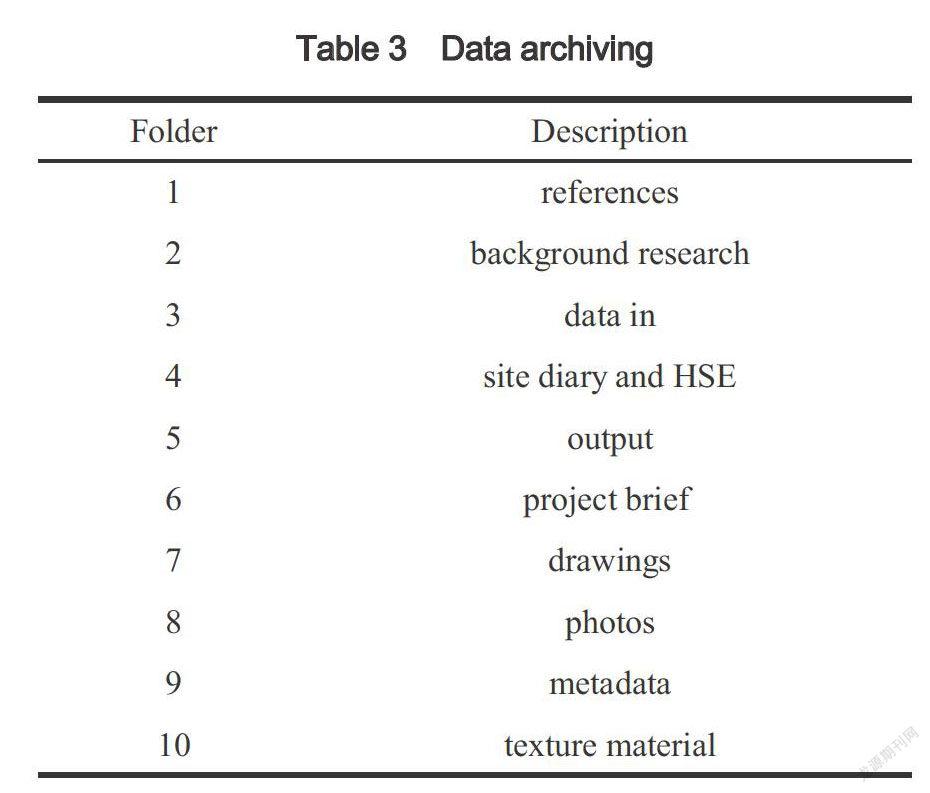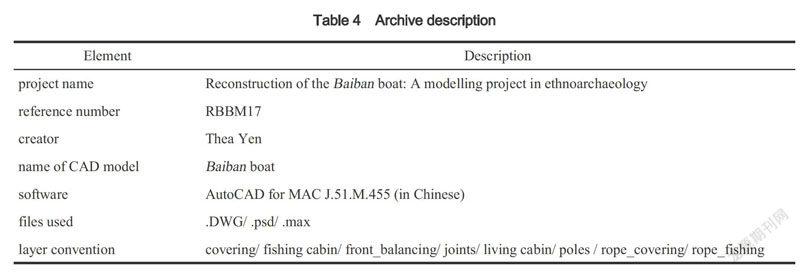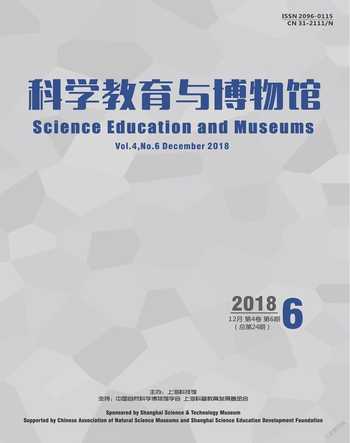重构白板舟:3D建模在疍民古船复原中的应用(英文)
Thea Yen



Abstract Computer graphics plays a crucial role in interpreting the archaeological works, both for academic researches and public engagements. This paper will examine the possibility of 3D modeling for the reconstruction of maritime archaeological material, the object of this project is the Baiban boat, a kind of Tanka sampan fishing boat, which is no longer in existence. By aiming at achieving the archaeological interpretation both in a pleasing format and precise level in the digital world, the boatbuilding of Baiban will be interpreted by reconstructing it via 3D modeling approach.
Keywords ethnoarchaeology, 3D modeling, boat reconstruction
0 Introduction
This paper will explore the use of geometric based modeling method as a process of modeling interpretative reconstruction of the Baiban boat, and to present it to the public through the formation of graphic. The project is aimed at showing the ability of the computer graphics imagery in archaeology. The paper will begin by discussing the reconstruction in archaeology, and reviewing the background of Baiban boat, allowing for a proper context for the model to be interpreted, followed by the analysis of the resource of the object, by evaluating the source of evidence. Subsequently the text will demonstrate the methodology and data management about the production process. After that a discussion on this project will be carried out, evaluating the referred programs and the deficiencies of this project. Finally, a conclusion will be drawn to sum up the report, and incidentally discuss the prospect of 3D reconstruction in archaeology.
1 Reconstruction in archaeology
Currently 3D interpretation is increasingly used in research and museums (e.g. VR museum in Vietnam by laser scan[1]; reconstruction of the Newport medieval ship by Rhinoceros 3D[2]; European Ship by Maya in digital in situ preservation archive[3]). When the object is reconstructed in right context, the modeling work could provide a higher level of expression for spaces and movement, as well as the exact texture of it.
The aim of this project is to produce a reconstruction of a disappeared boat, addressing 2D and 3D computer aided design and graphics skills. In terms of this reconstruction of the Baiban boat, the intention is to communicate the research outcomes at two levels; firstly at a basic level for the general public, and secondly for a more academic audience. This is aimed at building the connection between the academic field and the public, to visualise what the studied boat should be like based on the underlying plans. With the process of building the boat in software, one could therefore gain a better understanding of the construction of the boat.
2 Background
2.1 Importance
Generally, water means interaction, however, it was water that separate a group of people from the majority, water made them isolated. In southern part of China, there was a special ethnic population living on boats for the whole life, considering the water as land, which are called Tanka. The researches on the historical and folkloric aspects of this culture are sufficient. However, their dwelling place, the Tanka boat (figure 1), has not been taken seriously.
Since no first-hand description of any Tanka sampan boats had been published so far, not to mention the ones which are disappeared, it was decided to seize an opportunity to record their sampan boats, especially test the ability of 3D reconstructing the Baiban boat in this project.
2.2 General definition of "Tanka" boat
Tanka sampan, also known as egg boat. One of its purpose is used as a harbour boat, operated by Tanka people. Generally it is a shallow craft with a spoon-shaped bottom. It is decked both at the bow and stern, family live on the boat where is a separate area from passengers[4]. Generally the typical layout of the boat is, the fore-deck is used for operating the nets, the middle part of the hull is for storage, and the sheltered back is for living.
In early 20th century, there were various kinds of Tanka boats for different use, the names differ according to different operating ways (i.e. different fishing methods, different nets, amount of dwellers). 1932 statistics on Tanka people living on Pearl River showed, there were c.100 thousands Tanka people using c.30 kinds of boats[5].
2.3 The context of Baiban boat
Baiban boat has an unusual construction and represents the multiformity of the Tanka sampan beyond the common sampan construction. It shows the influence of the environmental factors, whereby the design of the vessel depends on the water condition (e.g. tides), luminous environment, wind etc. The peculiarity of this boat is reflected by its construction and operation (discuss below).
Baiban implies that this object was linked with the social practice. It has a totally different design from other Tanka sampan boats, as it was specifically constructed for one person and operated in different way. The reasons behind this have faded away through time.
3 Ethnographic parallels and sources of evidence
From the ethnological perspective, one can understand the "traditional" watercraft with the study of culture, filling the gap when there is no physical evidence discovered. Fortunately an interview was done in April of 2017 in the local area when most of the Tanka people don't want to recall the past hard life. The interviewee, Mr. Guo, has provided useful knowledge of Tanka boats during the interview. In terms of the types of the boat, the classification and the nomenclature of their boats mostly depend on how people operate them rather than the construction (Guo, 2017), as sampan are mostly built in the same planking technique.
The evidences for reconstructing this boat are mostly reliant on the ethnographic and iconographical information. One could gain a better insight of the object and understand the relevant social life by using the sources from the ethnographic perspective. The outcome is the answers which cannot be gained from purely archaeological survey. With first hand observation and interview with Tanka people, one could learn the object and the culture behind it, through the way in which the Tanka people view this study, what the technical choices are, which is a thick description of human behaviour in context[6]. However, the issues that need to be aware of is that the facts might be possibly skewed by the motives and requirements of the observer, or interviewees sometimes cannot provide the precise answers.
Using the source of iconography as evidence in archaeology could provide the detailed accounts of the records, but it also can lead to the unclear and over interpreted result. As it is based on the artist's rendition, they may be unlikely to provide an irrefutable definitive answer to an archaeological reconstruction; however, these could provide the additional information for the archaeologist to consider with a wide range of possibilities. From these points, the model in this project is considered as a reconstruction which places particular stress on the cultural and folkloric aspects representing the concept of the boat, rather than one with precise measurements.
4 Reading the Baiban boat
After the interview, Mr. Guo has communicated with several Tanka people who still keep the memory of the Baiban boat, collected the information about the measurements, raw timber materials and way of operation. Subsequently he has provided a sketch of the boat (figure 2), with the notes explaining how the boat was operated: the captain lived at the stem, a stone was placed at the bow for balancing. The two boards can be knocked-down with the vertical board and the strings in the fishing cabin. The boards were lacquered in white, this could lure the fish as fish have the characteristic of phototaxis. Fish cannot get out once they jump into the vessel. The basic measurements (table 1) and construction materials (table 2) are listed as below.
5 Survey methodology
After interviewing Tanka people about the vessel, it was decided to use Adobe Photoshop CC 2017 to ink up the three plan views of the boat, allowing for a clear view of the structure. Subsequently, the structured archive of AutoCAD 2015 will be created based upon the obtained plans. After further discussions with the interviewee, prior to his interpretation and his perceived ideas relating to proper reconstructions was obtained. After that, additional renderings were produced in 3D studio MAX with the exported AutoCAD-file. Data archiving complies to archaeological guidelines[7].
6 Understanding hull construction by modeling
Stage 1: Producing a plan in Photoshop
Initially the sketch of the boat was digitised in Photoshop, to producing the three orthographic views, which could provide the pre-defined views and additional 2D data (figure 3). Mr. Guo's drawing is a descriptive sketch rather than a precise one, so the scales of the longitudinal view and cross section needed to be corrected in Photoshop. The plan view was created in accordance with the data from longitudinal view and the cross section.
Stage 2: Hull construction
AutoCAD was the software for creating the layout of the hull, the measurements of each part were imported while building the structures, as figure x shows the 2D view of it. Firstly, the fishing cabin was squeezed out with measurement of 900 cm, followed by processing the living cabin (250 cm) and the bow cabin (80 cm).
Subsequently, every parts were joined together. The modeling sequence could be considered as a hypothetical imitation of the building sequence in reality. The awnings were defined as a structure which could stretch out and draw back, comprised of two pieces (Guo, 2017). The line transect was created first, followed by squeezing out the shape of the awning, then turn into polygons. When one awning was finished, it is copied to create another one, and its size is slightly reduced to fit the structure. The vertical board was attached to the hull by using a mortise and tenon joint, the other board was roughly tied up by ropes to the hull (see figure 4 illustrating the digital construction sequence, and figure 5 is an exploded model which gives a structural interpretation). The completed hypothetical construction in AutoCAD was showed in figure 6.
Stage 3: Defining the material and texture
The chosen materials (figure 7) for building every part of the Baiban boat mainly rely on the description of Mr. Guo and the information from previous shipbuilders (Guo, 2017), as there is no physical remains to provide precise information. Besides, the raw materials used in other existing Tanka sampan boat around the Pearl River are taken as reference, since the choice of timbers and the design of the structure at that area was similar[8]. Some designs of the structure such as that the awnings are foldable, which is a noted similarity among most of the Tanka sampan, as the hull should be uncovered during working hours and covered up during night time, are fairly typical of Tanka sampan.
Stage 4: Lighting analysis
When analysing the lighting, the operation environment of the boat could be understand in a right context. Concerning this fishing boat was working at night, the first consideration was choosing the light effect at night (figure 8) to show the function of two boards which are white-lacquered for alluring the fishes. However, this cannot result in a clear presentation of the structure. Therefore it was decided to using the surrounding at dusk. Figure 9 are the final result after V-Ray rendering.
7 Data management
Data archiving is complied to archaeological guidelines. Table 3 and Table 4 showed how the data were managed in detail.
8 Discussion
8.1 Level of interpreting accuracy
The reconstructed one should be considered as a representative Baiban boat, rather than an original one. There will be the uncertainty in terms of the actual parameters of the model, the data given by the observer. This is not taken in to consideration, since the aim of the reconstruction is interpreting the feature of the boat
8.2 Evaluating the project and software
Recently photogrammetric modeling is widely applied in archaeology, as it could create a model in an easier way to some extent and is suitable for publicity. From this point, it needs more effort when the object should be manually constructed with the geometric modeling method. However, photogrammetric model is generated by scanning the surface, one cannot find the actual construction of the model, while AutoCAD-file and Max-file could be saved and exchanged with other platform, and the solid structure could be easily accessed and further edited. They also have the possibility to achieve the reconstruction of an object when there is no physical remains for reference. The formal analysis including structure, lighting, movement, surrounding (visibility) could be mostly achieved as user's pre-defined views in these softwares.
AutoCAD was first released in December of 1982. In June of 1992, AutoCAD release 12 was debuted, which was the last version to support both Windows and Mac operating systems for more than 16 years[9]. Subsequently in October of 2010, AutoCAD 2011 for Mac was released[10]. AutoCAD 2015 for Mac was used in this project, which is tailored for OS X. In any case, whether it is AutoCAD for Windows or for Mac, AutoCAD-files can be saved and exchanged with other platform and on almost any release, enabling user to share files. In terms of exploring this software, using the tips shared on auto desk forums for reference will be helpful. The help menus are also recommended for tips and tricks to make the most of this software.
What needs to be noticed is the basic structure produced in AutoCAD, which need consideration for further processing such as putting texture onto the model. The surface of the frames should be suitable for the next step; otherwise it will increase difficulty for rendering the model.
When the structure was done in AutoCAD, the further modeling process (i.e. rendering, lighting) could be done in various programs such as 3D studio MAX, Sketch Up, Autodesk Maya and Adobe Photoshop CC. The reason for choosing 3D studio MAX is that the program has a better possibility for rendering. However, in terms of 3D public viewing, the rendered result cannot be easily accessed, as the program is mostly designed for provide a 2D rendering image. One could use this possibility to build animation by creating key frames. This model need further improvement such as produce the animation to show how the boat was operated, how did it exactly look like when it was used for fishing at night, also adding the movement and sound effect could provide a better context for it.
9 Conclusion
During the modeling process, the issues are how much conjecture will affect the level of facticity, and to not over interpret each element. Predefined view and the prospective result could be the crucial reminders when processing the model, which could guide the work in right direction and get a desirable outcome at the end. Beyond all doubt there is a lot of room for it to improve, as aforementioned the vessel could be inserted to interpret the reconstruction in a more detailed and immersed scene.
Computer graphics plays a crucial role in interpreting the archaeological works, both for academic researches and public engagements. Ideally it is possible to achieve the archaeological interpretation both in a pleasing format and precise level in the digital world. This requires the critical evaluation of the project, sufficient research of the background, precise metadata in preparation and the proficiency with the software.
Reference
[1]VR3D. First 3D Virtual Museum with 3D Scans of Ancient Relics: Ancient Sculptures of Vietnam[EB/OL]. http://vr3d.vn/trienlam/virtual-3d-museum-ancient-sculptures-of-vietnam.
[2]JONES T, NAYLING N, PAT TANNER P. Digitally Reconstructing the Newport Medieval Ship: 3D Designs and Dynamic Visualisations for Recreating the Original Hull Form, Loading Factors, Displacement, and Sailing Characteristics[C]. Underwater Archaeology Proceedings, 2013.
[3]Digital in Situ Preservation Archive. 16th-century Portuguese Nau[EB/OL]. https://sketchfab.com/models/814494e 93e7d434cb9c9603aeaa9fc8c.
[4]PARRY M. A Dictionary of the World's Watercraft: From Aak to Zumbra[M]. London: Chatham Publishing, 2001.
[5]CHEN Xujing. The Study of the Culture of Tanka[M]. Shanghai: The Commercial Press, 1946.
[6]Clifford Geertz. The Interpretation Of Cultures[M]. New York: Basic Books, 1973: 470.
[7]Archaeology Data Service. Guidelines for Depositors Version 3.0[EB/OL]. http://archaeologydataservice.ac.uk/advice/ DepositingData#section-DepositingData-HowToDeposit.
[8]HUANG Xinmei. An Investigation of Boatsmen Tangka at Outlet of Pearl River[M]. Guangzhou: Zhongshan University Press, 1990.
[9]David E. Weisberg. The Engineering Design Revolution[EB/OL]. http://cadhistory.net/toc.htm.
[10]CLARK D. Autodesk Adopts Apple App Store for Mac Software[EB/OL]. https://blogs.wsj.com/digits/2011/08/16/ autodesk-adopts-apple-app-store-for-mac-software/?KEYWORDS=AutoCAD

